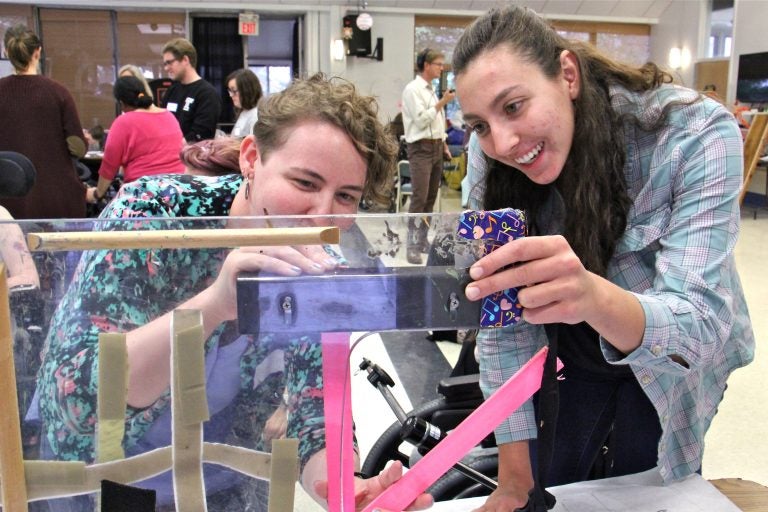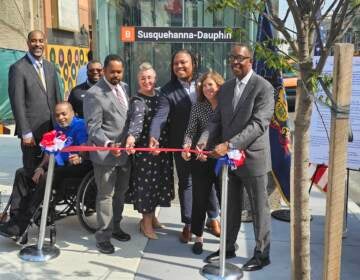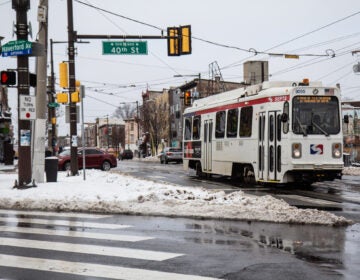Disability and design: Creating equitable spaces
COVID-19 has shown how our cities and spaces can fail to keep us healthy. But for the 15% of the population living with a disability, this awareness came before the pandemic.
Listen 49:45
Rachel Adler (left) and Nicole Maximowicz take measurments before designing a wheelchair tray that will protect Ana's communication device. (Emma Lee/WHYY)
COVID-19 has highlighted the many ways our cities and buildings can fail to keep us healthy. But for the 15% of the population living with a disability, this awareness came long before the pandemic. Today, we speak with World Enabled’s VICTOR PINEDA and SARA HENDREN, author of What Can a Body Do? How We Meet the Built World. They will discuss how people with disabilities have been left out of the conversation about urban planning and design and how that can and should change moving forward.
Interview highlights:
On ingenious design:
Marty Moss-Coane: Sara, you profile a number of people in your book, including a guy named Chris. He’s an engineer. He doesn’t have an arm. And there’s a picture of him changing his baby’s diaper with a design that he really created in order to be able to do that. Can you talk a little bit about Chris and what his experiences and innovations can teach us about this world we’re talking about?
Sara Hendren: Yeah, I mean, so much of what I want people to see in the book, and in the places where design meets disability historically, is again the creativity that comes with the urgency of human rights. I mean, I think sometimes people can get their heads around the human rights issues, but they miss the creativity and ingenuity that’s happening by disabled people. So, you know, Chris, as you said, he was born with one arm and he was somebody for whom lots of prosthetic arms were built as a child and offered to him. But his body was sufficiently adaptive and plastic, like we all are, he was deeply adapting to his world as a one armed person. And he mostly does his job as an engineer with his one hand and with his incredibly dexterous feet and toes. And the body is amazing this way. But he did find himself, when his newborn baby arrived, with what tends to be a two handed task, and that is changing his baby’s diaper. And so I profiled him there. We meet him in that domestic setting to see that he actually wasn’t somebody who wanted to get one of those universal arms that comes out of the laboratories and is this kind of gee whiz, high tech cyborg, you know, sort of breathless technology of the future, but instead a quite humble and nimble and Just-In-Time set of objects that he created himself. It’s like a little felted wool cord, you know, kind of harness that he hangs from the residual limb on his right side to suspend the ankles of his baby so that he can do the the work of swapping out that diaper. And so that’s in a chapter called Limb that joins a whole vast history of prosthetics. It is so fascinating what comes, yes in the high tech rehabilitation engineering that happens at the laboratories right now, but also happens in people’s living rooms and happens globally across the world in low tech forms and highly affordable and distributed for free forms like the Jaipur foot in India at clinics all over India. And what I wanted people to see is that there’s this ingenuity that is this realm of expertise and deep wisdom that everyone can learn from. And it’s probably in places that you wouldn’t expect.
On cities that work:
M: Victor, let me go back to you. Is there a city that you have been to or you know about where you feel as if this sort of design and disability has come together to create a place that’s easier to navigate, not just for people in a wheelchair, as you are, but for everybody that we’ve all benefited because of these design innovations?
Victor Pineda: Sure. I think, so no city has it right, this is a journey. It’s not a destination. And it is very much about a complex set of factors that have to come together. But cities like Oslo or cities like Helsinki, some of those Nordic countries have a high premium on design. And they, since the 70s, had really great design thinkers putting their ideas on universal design into practice in the built environment. And part of the conversation I had last night with the city of Abu Dhabi was describing how, when I arrived to Oslo for a conference, I literally got off the plane, the train station was in the airport. So I didn’t have to cross the street or get a cab or try to navigate other kinds of obstacles to get to my hotel. I got on a high speed train that was fully accessible. A little ramp came out of the train to the ease and delight of me and my traveling companions. I sat on the train and just a couple hours later, I was on the other side of the country. I got off the train station, crossed the street, and was able to check into my hotel without any additional burdens. And that kind of design really is about ensuring that all kinds of bodies, you know, families and older persons. If I were to travel with my grandmother, I would love to go to Norway again because I know that she would be able to go with me and we wouldn’t have to encounter other obstacles.
On designing the world for Down Syndrome:
M: Sarah, let me go back to you. And you write about your your son Graham in this book as well. It’s about many different things, but it’s also has a very personal story that you have to tell about having a child with Down Syndrome and how perhaps that has helped you understand the world that we’ve created, how it maybe works for him sometimes, why it works against him sometimes. Can you speak to that?
S: Yeah. I mean, the book is mostly a sort of journalistic tour through physical design in lots of places. So people who use prosthetic limbs, the design of furniture, the design of homes and urban planning. And at the end of the book, I do talk a little bit about design for developmental disability because it’s not an obvious place for design. And we think of design maybe as a kind of extension of the body to either bring the body to the world a little more easily or to bring the world to the body a little more easily. But again, in developmental disability, the kind of misfitting – so Rosemary Garland Thompson, whose a disability scholar talks about disability as a misfit condition, which sounds like common sense, except she says a misfit is a square peg in a round hole. And what that means is that the misfit is actually running both ways. So the question to ask for somebody like my son Graham, who has Down Syndrome is, is he a misfit in the world or is the world misfitting in its normative structures for him? And what would be the moves to make to try to make the world more capaciously expansive for all kinds of people to flourish? And that’s been the question that he’s helped me understand acutely in the 14 years of being his parent. But also he launched a decade of my own study professionally and looking into this in the disability community for the last couple decades. And I will say, I mean, you know, what is the kind of misfitting in Down Syndrome? That non-normative intelligence is a misfit with the kind of normative economic time that we live under. So the misfit is not so much about replacement parts or about the sensory or mobility capacities of the body, but it’s about his kind of misfit with becoming what a lot of us are conscripted to become, which is an economic unit as a measure of our worth. Can we proceed through school and the normative structures of jobs and become taxpaying citizens in a way that other people will see as worthy? And I think Down Syndrome challenges that in a powerful way.

Subscribe for more Radio Times
WHYY is your source for fact-based, in-depth journalism and information. As a nonprofit organization, we rely on financial support from readers like you. Please give today.




